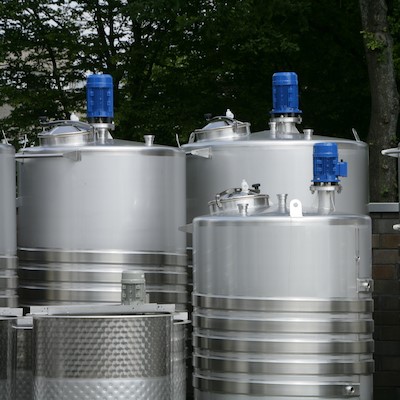
Durability of Stainless Steel: Which Material is Right for Your Application?
Stainless steel is highly sought after in various industries due to its versatility and durability. In tank construction—whether for storing liquids, chemicals, or food—various stainless steel alloys are used, offering distinct advantages depending on the application. But which stainless steel alloy is best suited for which application? In this article, we explain the differences between the most common stainless steel alloys and provide guidance on which alloy is best suited for different industries. At the end of this article, you will find a practical link to a resistance chart that can help you select the right material.
1. What is meant by the chemical resistance of stainless steel?
The chemical resistance of stainless steel refers to the ability of a specific stainless steel alloy (e.g., 1.4404 or 1.3401) to withstand aggressive chemical influences such as acids, alkalis, and salts without compromising its structure or functionality. This property is particularly crucial in environments where materials are continuously exposed to corrosive or reactive substances. If an alloy's resistance is insufficient, chemical reactions can occur that weaken the material's integrity, potentially leading to leaks or fractures in the tank.
2. What are the advantages of stainless steel in tank construction?
Stainless steel is known for its excellent corrosion resistance, which is due to the alloying of iron with chromium. Chromium forms a stable, passive oxide layer (chromium oxide) on the surface, protecting the underlying metal from further attack. This layer self-renews after minor damage, providing an effective barrier against many chemical substances.
The terms “V2A tanks” or “V4A tanks” are commonly used as categories for popular stainless steel grades. However, these actually encompass a much broader range of stainless steel alloys. By adding other elements such as nickel, molybdenum, or titanium, additional specific properties can be achieved, such as increased resistance to aggressive chemical media or improved mechanical strength at higher temperatures.
3. Chemical resistance in specific applications
Stainless steel is widely used in various industries due to its versatility and chemical resistance. Some of the most common application areas include:
- Dairy & Milk Processing: For processing dairy products like fresh milk, yogurt, or cream, the material V2A (1.4301) is most commonly used. In cases where particularly acidic or fermented dairy products are processed and the pH value decreases, higher alloyed V4A materials (1.4404) can extend the tank’s lifespan.
- Food and Beverage Industry: In food production, V2A stainless steel (1.4301) is sufficient for most process applications. This ensures resistance to most cleaning and disinfecting agents used during regular CIP cleaning. If higher salt concentrations (e.g., in sauces or processed meats) or high concentrations of organic acids (e.g., acetic acid, lactic acid) are present, V4A alloys such as 1.4404 or 1.4571 may be the better choice.
- Pharma and Life Sciences: In these industries, not only the chemical resistance but also the surface quality and purity of the stainless steel are crucial. With especially smooth surfaces (e.g., 0.4 Ra), the tank’s interior is particularly resistant to microorganism deposits and easy to clean. V4A materials like 1.4404, 1.4571, or 1.4435 are therefore widely used in pharmaceutical storage tanks and similar applications in the life sciences and medical technology sectors.
- Chemical Industry: In the chemical industry, extreme conditions such as high temperatures (e.g., 200°C), dynamic loads from agitators, or reactions under pressure and vacuum place special demands on material quality. Reactors for specialty chemicals or agrochemicals are therefore primarily made from 1.4571 and similar V4A alloys. In cases of high concentrations of corrosive substances such as sulfuric acid or caustic soda, even higher alloyed stainless steels or duplex materials may be required to ensure the tank's longevity. However, in some areas of the chemical industry, V2A materials such as 1.4301 can also be used without issue, particularly in sectors like paint and coating chemistry or for storing non-critical raw materials and finished products.
4. Challenges and limits of stainless steel’s chemical resistance
Despite the wide variety of alloys, stainless steel reaches its limits under certain extreme conditions. For example, stainless steel can be prone to pitting corrosion in environments with highly concentrated chlorides, such as saltwater or during the processing of specific chemicals. In such cases, special steel grades with higher molybdenum content, such as type 1.4549 (904L), or superalloys like Hastelloy may be required.
5. Chemical resistance charts as a tool for material selection
Since the chemical resistance of stainless steel varies depending on the alloy and environmental conditions, specialized resistance charts are an indispensable tool for engineers and planners. These charts provide a quick overview of how different stainless steel types react when exposed to various chemicals and which materials are best suited for specific applications.
For example, Bürkert offers a comprehensive chemical resistance chart containing detailed information about how different materials, including stainless steel, resist a wide range of chemicals. These charts significantly simplify the decision-making process, especially in industries dealing with aggressive media.
Conclusion: Stainless steel – an indispensable material with excellent chemical resistance
Choosing the right stainless steel is critical when procuring a storage tank or pressure vessel to ensure long-term corrosion resistance and production safety. Stainless steel remains an indispensable material in the industry due to its chemical resistance, versatility, and availability. With ongoing alloy developments, stainless steel is increasingly tailored to the requirements of the food, pharmaceutical, and chemical sectors, ensuring its continued role as the most important material in industrial tank construction in the future.
You can access the Bürkert resistance table here